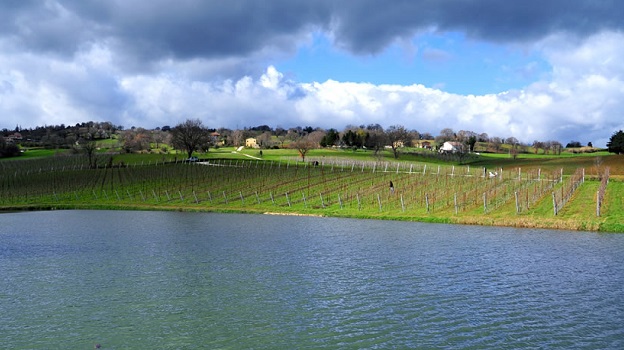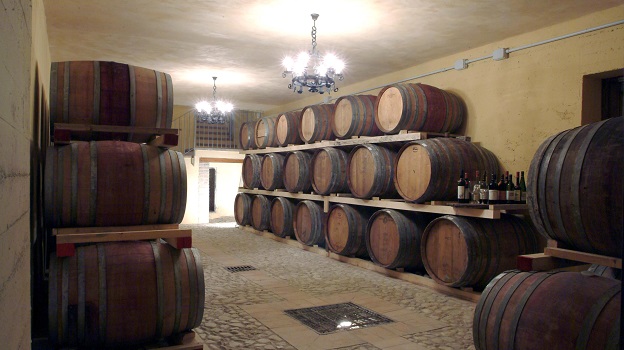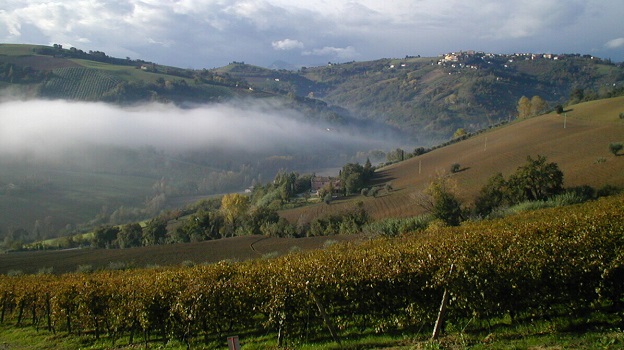Browse using the new Vinous website now. Launch →
Printed by, and for the sole use of . All rights reserved © 2015 Vinous Media
New Releases from the Marche: Something for Everyone
Wine is a serious matter in the Marche. There are roughly 14,200 estates in the region, working with about 17,000 hectares of vines. Although cooperatives do exist, wine production is very much a family affair. Roughly 80% of the Marche’s wines are DOC or DOCG, a fact that does not guarantee quality in and of itself (individual producer skill is important) but illustrates the region’s potential. In fact, the region is blessed with many high-quality native grape varieties and unique terroirs. Even better, the average level of quality is quite high, which means that finding a truly bad wine is difficult. A handful of overoaked and rustic reds are still being made, but for the most part the Marche’s wines deserve to be on shopping lists of wine lovers everywhere.
The Grapes Of The Marche
One of Italy’s most important native cultivars, Verdicchio takes its name from verde (green), the color of both the grape and the wine (even with age, Verdicchio wines never lose their green tinge). One grape, Verdicchio, yields two wines, Verdicchio dei Castelli di Jesi and Verdicchio di Matelica, but the wines are very different due to completely dissimilar terroirs. Other Marche white grapes include Maceratino (also called Ribona) and Biancame, two native grapes long thought to be similar to Trebbiano Toscano but that have greater potential for making fine wines.
The Marche is also the birthplace of Pecorino, currently Italy’s hottest white grape, but unlike winemakers in nearby Abruzzo, most Marche producers tend to macerate the must on the skins for extended periods of time, making for some very thick, and, to my way of thinking, less enjoyable Pecorino wines. Producers who throttle back on extraction, such as Cocci Grifoni and San Savino/Podere Capecci, are most successful. But, as in Abruzzo, Pecorino’s recent popularity has led to a wave of new bottlings that barely remind me of their variety.
Passerina is another up-and-coming variety, at least in the Marche and Abruzzo where the same Passerina variety appears to be grown (there are many different biotypes of Passerina planted all over Italy, many of which I am sure are not Passerina at all). Passerina wines from these two regions are similar: usually more floral and less structured than those made with Pecorino.
The two red grapes typically associated with the Marche are Montepulciano and Sangiovese, which are usually blended together in varying percentages. International varieties are also grown; they were misguidedly planted here like everywhere else in Italy during the boom years of the ’80s and ’90s but they rarely yield wines of interest. Absolutely unique to the Marche are Vernaccia Nera, Vernaccia Rossa (actually a biotype of Aleatico) and Lacrima, three aromatic red grapes that can give highly idiosyncratic but outstanding red wines. The two Vernaccias are unrelated; the former is used to make the wines called Vernaccia di Serrapetrona and Serrapetrona Rosso, while the latter is used to make Vernaccia di Pergola and Pergola Rosso. Both varieties can make dry and sweet red wines, and Serrapetrona is historically associated with delightful sparkling wines. Lacrima is the grape from which Lacrima di Morro d’Alba is made, one of Italy’s most pungently fragrant wines of all.

Vineyards around the small, artificial lake at Andrea Felici
The Wines Of The Marche
The Verdicchio dei Castelli di Jesi production zone includes virtually all the towns in the province of Ancona, the Marche’s main seaport. “Castelli di Jesi” refers to a string of very pretty medieval hilltop towns of which the most famous is Jesi. The denominazione can be divided into two sections. The northernmost one, which extends to the valleys of the rivers Miso and Nevola, is roughly rectangular in shape and includes towns like Arcevia, Corinaldo, Ostra and Pergola. A smaller area extending south towards the Esino river (an area including towns like Apiro and Cupramontana) and Jesi is the “Classico” zone. The Castelli di Jesi production area is mainly characterized by gently sloping hills, a moderate climate and mainly marl and clay soils, but there are differences worth knowing about. For example, the area around the town of Serra de’ Conti has an almost marine climate, with warmer average temperatures resulting in earlier harvests (typically finished by the second week of September) and richer, softer wines.
The more inland areas around Montecarotto and Cupramontana are located at higher altitudes in much cooler microclimates. Verdicchios made with grapes grown in these areas are some of the denominazione’s most refined, minerally and ageworthy. Here grapes are usually harvested about 10 to 14 days later than in the rest of the Castelli di Jesi area, usually never before October. Not surprisingly, the more successful Verdicchio sparkling wines are made with grapes grown here. I believe that it’s a huge shame that Verdicchio producers haven’t had the courage to make these terroir-related differences more apparent over the years with cru bottlings, but it’s also true that many estates own vineyards scattered throughout the region. Hence, wines are often blends from multiple sites, which obviously blurs specificity of terroir.
And winemaking styles are important as well: some producers prefer reductive winemaking techniques highlighting floral and fruity aromas and flavors (passion fruit, green fig, fresh citrus), while others prefer slightly late-harvested grapes and produce creamier wines with a distinctive almond quality, which has always been considered the sine qua non in all Verdicchio wines). Last but not least, Verdicchio di Castelli di Jesi Riserva wines are almost always oak-aged and have improved greatly over the last decade. They were once too oaky and marked by what seemed like generous doses of residual sugar, but that is no longer the case.
With only 300 hectares of vines compared to Castelli di Jesi’s 3,000, Verdicchio di Matelica is one of Italy’s best-kept wine secrets, producing a number of refined minerally, high-acid whites that take on dry Riesling-like notes with age. The Matelica zone is a narrow mountainous area located in the upper Esino river valley between the towns of Fabriano and Cingoli, including hamlets such as Castelraimondo, Matelica and Cerreto. It is characterized by cold winds and soils with a high limestone content; the wines of Matelica are recognizably higher in acidity and more minerally than the more floral and fruity wines of the Castelli di Jesi.

The cellar at Villa Ligi
Rosso Conero, Rosso Piceno and Marche Rosso are the best known of the Marche’s red wines. The Rosso Conero DOC, created in 1967, allowed only two grape varieties, Montepulciano (a minimum of 85% of the total blend) and Sangiovese (the remaining 15%). Riservas could also be made from the best grapes and must be aged longer in oak. In 2004, new Rosso Conero production guidelines were put in place: the 15% Sangiovese minimum was replaced by a minimum 15% of any local non-aromatic red grape (a horrible idea, in my view) and a new wine was introduced, the DOCG Conero Riserva. For the latter, only Montepulciano and Sangiovese may be used, always with the same 85/15 mix.
The areas around Candia, Castelfidardo, Loreto (do not confuse this town with Abruzzo’s Loreto Aprutino, where the famous Valentini estate is located) and Offagna have deep clay-rich soils, while those closer to the Conero mountains are generally more calcareous. However, while clay-and-calcaire soils dominate around Montaucuto, Poggio degli Angeli and Poggio Varano, limestone is even more abundant around the Poggio di Ancona, which is clearly shown by the much more intense white color of its soils. The presence of clay increases near Camerano, while soils around Numana and Coppo are much more varied, with clay, limestone and sand dominating in various spots. Unfortunately, as is often the case, it’s hard to generalize about single Rosso Conero terroirs since many estates blend grapes from different soil types. Generally speaking, Rosso Conero wines are big and sturdy, making up in power what they lack in elegance. Without doubt, they are some of the Marche’s most accomplished reds.

Tenuta Cocci Grifoni focuses exclusively on indigenous varieties
Rosso Piceno can be made in the provinces of Ancona, Ascoli Piceno and Macerata and in terms of production volume is the Marche’s biggest DOC. Unlike Rosso Conero, in which Montepulciano dominates the blend, Rosso Piceno had always been Sangiovese-based (until 1997, the blend was at least 60% Sangiovese), making for some of Italy’s more delicious lighter-bodied red wines. Unfortunately, production guidelines were changed, and now up to 70% Montepulciano is allowed in Rosso Piceno wines. In my view, this was a huge mistake because what used to be two recognizably different Marche red wines (Rosso Piceno easygoing and light-bodied, Rosso Conero bigger and more structured) are no longer as dissimilar. Besides Rosso Piceno, Rosso Piceno Superiore wines are made in a smaller, historically famous wine-producing area in the southern reaches of the Marche close to the Abruzzo border. It’s potentially the best Piceno wine, but the level of quality is uneven across producers.
Marche Rosso is the denominazione used to name wines made with hefty doses of international grapes. I well remember when these wines, back in the ’90s, were thought of some Italian critics as the highest-quality red wines of the Marche, but anybody with even minimal knowledge of the world’s great red wines knew better. At best, such wines are boring and without “somewhereness”; at worst, they are overoaked and tough, and ultimately do very little to advance the Marche’s cause.
Made just east of Ancona, Lacrima di Morro d’Alba is one of the Marche’s most interesting wines, thanks to its highly aromatic nature (not unlike a dry Black Muscat). Both dry and sweet (passito) wines are made and wine quality today is generally very high. There are still a few too many inky, overly tannic Lacrima wines that speak very little of the variety (they’re probably loaded with too much Montepulciano), but they are the minority now. A good Lacrima wine is graceful and full of aromatic charm and can be enjoyed lightly chilled. There are few more intensely perfumed red wines in Italy but if aromatic grapes are not your thing, look elsewhere.
One of Italy’s most interesting and at times best wines, Vernaccia di Serrapetrona is produced in an inland area near the southern reaches of the Matelica area, with vines planted as high as 2,200 feet above sea level. Production is concentrated mainly around the towns of Belforte del Chienti, San Severino Marche and Serrapetrona. Vernaccia di Serrapetrona is a delicately sparkling dry or sweet red, and a more tannic, structured still wine called Serrapetrona Rosso is also made.
Panoramic view over Sartarelli's Balciana Vineyard
Other Noteworthy Marche Wines And Production Areas
Offida, Bianchello del Metauro, Colli Maceratesi, Falerio dei Colli Ascolani, Esino, and Colli Pesaresi are less-known production areas but not totally without merit. Each can boast a talented producer or two who makes very good wines. Offida is especially interesting, excelling with the Pecorino and Passerina grape varieties, and even Offida Rossos hold more interest than many Rosso Piceno and Rosso Conero wines. Bianchello del Metauro and the Colli Maceratesi are emerging areas we are likely to hear more about in the near future; the former’s white wine are lighter and fresher, the latter’s richer and slightly deeper.
Recent Vintages In The Marche
The 2014 vintage, much maligned owing to almost non-stop rains and cooler temperatures all year long, was generally better in the Marche (especially in the Castelli di Jesi) than in most other regions of Italy. The Verdicchio was able to ripen slightly later in the fall, during a period featuring lower daytime temperatures, and thus benefited from a longer growing season. Clearly, some wines are less concentrated than usual due to bloated grapes, but overall they show excellent aromatic character. The 2013 vintage wasn’t easy either: frequent rain showers in June and July and an unheard-of eight days of rain during the harvest hampered quality. By contrast, 2012 and 2011 were both hot years, but the wines differ greatly. In 2012, daytime temperatures were high through most of the growing season, and so the vines adapted and the grapes were able to reach optimal ripeness. But in 2011, the heat came suddenly and brutally in August, shriveling grapes directly on the vine; those that didn’t turn to raisins often failed to achieve physiological maturity. Consequently, some 2011 reds are marred by cooked aromas and flavors and gritty tannins.
You Might Also Enjoy
Italy: Odds and Ends, Antonio Galloni, July 2015
Friuli: It Is What It Is, Antonio Galloni, June 2015
Looking at Italy Through Rosé Tinted Glasses: Cerasuolo, Rosato, Ramato and Chiaretto, Ian D'Agata, June 2015
The Wines of Abruzzo and Molise, Ian D'Agata, May 2015
Alto Adige: A Pause for Thought, Antonio Galloni, May 2015
Exploring Roero, Antonio Galloni, May 2015
2011 Barolo: The Here and Now, Antonio Galloni, March 2015
-- Ian D’Agata
Show all the wines (sorted by score)
- Andrea Felici
- Angelini
- Aurora
- Belisario
- Bisci
- Boccadigabbia
- Brunori
- Bucci
- Casalfarneto
- Clara Marcelli
- Cocci Grifoni
- Collestefano
- Colonnara
- Fattoria Villa Ligi
- Fazi Battaglia
- Fontezoppa
- Garofoli
- Il Pollenza
- La Monacesca
- La Staffa
- Le Terrazze
- Marchetti
- Maria Pia Castelli
- Mario Lucchetti
- Marotti Campi
- Montecappone
- Moroder
- Oasi degli Angeli
- Pievalta
- Saladini Pilastri
- San Savino - Podere Capecci
- Santa Barbara
- Sartarelli
- Stefano Mancinelli
- Tenuta dell'Ugolino
- Tenuta di Tavignano
- Umani Ronchi
- Vallerosa Bonci
- Velenosi

